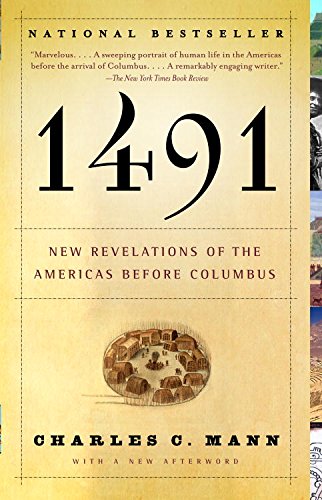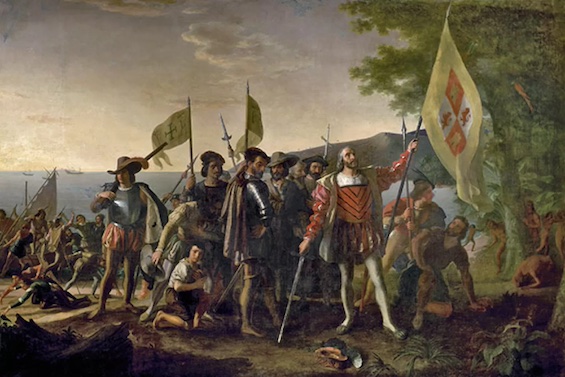
Estimated reading time: 6 minutes
Forget just about everything you learned in school about the peoples of the Americas before 1492—and about the land, too. It turns out that yesterday’s historians, anthropologists, paleontologists, and ecologists got it pretty much all wrong.
As Charles C. Mann explains in this revised edition of this bestseller, latter-day investigations in all these fields have turned up persuasive evidence that the Americas before Columbus were far more heavily populated, the leading civilizations far more sophisticated, and their origins far further back in time than earlier generations of scholars had suspected.
The greatest empire on Earth
“In 1491 the Inka ruled the greatest empire on earth,” Mann writes. “Bigger than Ming Dynasty China, bigger than Ivan the Great’s expanding Russia, bigger than Songhay in the Sahel or powerful Great Zimbabwe in the West Africa tablelands, bigger than the cresting Ottoman Empire.” And population density both in the Andes and in Mesoamerica was the highest in the world. “The central Mexican plateau alone had a population of 25.2 million. By contrast, Spain and Portugal together had fewer than ten million inhabitants.” Central Mexico housed more than twice as many people per square mile as China or India.
1491: New Revelations of the Americas Before Columbus by Charles C. Mann (2006) 541 pages ★★★★★

What we now know about the Americas before 1492
Consider these three less widely known facts about the New World Columbus “discovered:”
- The legendary bloodthirstiness of the Aztec (more properly called the Triple Alliance) needs to be seen in context. “If England had been the size of the Triple Alliance, it would have executed on average, about 7,500 people per year, roughly twice the number Cortes estimated for the (Aztec) empire. France and Spain were still more bloodthirsty than England.”
- “The corpus of writings in classical Nahuatl, the language of the Alliance, is even larger than the corpus of texts in Classical Greek.”
- The deciding factors in the Europeans’ legendary ease of conquest were disease (smallpox above all) and political infighting within native communities. Compiling recent studies, Mann estimates that “In the first 130 years of contact about 95 percent of the people in the Americas died.” And, more to the point, smallpox and other virulent diseases sped through both North and South America far more quickly than the conquerors. “Smallpox visited before anyone in South America had even seen Europeans . . . The first whites to explore many parts of the Americas therefore would have encountered places that were already depopulated.”
Humans first cross into North America much earlier than thought
Recent archaeological excavations have pushed back the date of arrival of homo sapiens in the Western Hemisphere from around 9000 B.C.E. to as much as 30,000 or 40,000 BCE. One site on the Peruvian coast, Aspero, “might win the title of the world’s oldest city—the place where human civilization began.” And “people were thriving from Alaska to Chile while much of Europe was still empty of mankind and its works.”
Europeans didn’t encounter virgin forest and prairie in North America
The landscape encountered, first by the Pilgrims and later by American settlers pushing ever further West, was anything but the virgin forest and prairie they thought it was. “Native Americans burned the Great Plains and Midwest prairies so much and so often that they increased their extent; in all probability, a substantial portion of the giant grassland celebrated by cowboys was established and maintained by the people who arrived there first.” On the Eastern seaboard, too, Indians extensively used fire, clearing tracts for farming and completely transforming the land before Europeans ever set sight on the coast.
Surprisingly, the Amazon was home to millions
Even the Amazon basin, long thought to be pristine territory, was home to millions of people long before disease introduced by the Spaniards decimated them and left their extensive works throughout the region to the ravages of rain and the forest. Mann notes that “the Amazon’s wealth of fruits, nuts, and palms is justly celebrated.” He adds a comment from one of his innumerable interviews with scholars: “‘Visitors are always amazed that you can walk in the forest there and constantly pick fruit from trees. That’s because people planted them. They’re walking through old orchards.”
Mann’s detractors
As Mann makes clear throughout 1491, practically all these findings have their detractors. Some cling to old findings (often their own) and simply refuse to accept changed views. Others criticize the methodology (or the investigator). But that’s to be expected. In fact, a collection of scientists in just about any field will behave like the Israeli Knesset, divided into nearly as many factions as there are scientists.
However, I’m inclined to side with those detractors on one point. Mann’s assertions about the dates of humans’ first arrival in North America are disputed. Others date the first humans crossing the land bridge from Siberia to Alaska to anywhere between 13,000 and 29,000 years ago. Most scholars think 30,000 to 40,000 years is unlikely.
But, on the whole, the case Mann sets forth is compelling, controversy notwithstanding. And for anyone with even a smidgen of interest in history, anthropology, paleontology, or ecology, these revelations must be surprising. For a history buff like me, they’re mind-bending.
About the author

Charles C. Mann is the author or coauthor of eight nonfiction books, mostly about scientific and technical topics. He is a contributing editor for Science, The Atlantic Monthly, and Wired. Mann was born in 1955. He graduated from Amherst College in 1976. He lives in Amherst with his wife and children.
For related reading
Mann’s research is thorough, as is evident with a glance at the extensive bibliography and notes crammed into both this book and its successor, 1493, which I reviewed at After the Columbian Exchange, nothing was ever the same.
A Yale historian rests her argument in part on the same set of facts Mann reports in this book. See The Year 1000: When Explorers Connected the World—and Globalization Began by Valerie Hansen (When did globalization begin?)
You’ll find this book on The 40 best books of the decade. This is also one of the books I’ve included in my post, Gaining a global perspective on the world around us.
You may also enjoy browsing through 20 top nonfiction books about history. And if you’re looking for a broader view of human history, check out New perspectives on world history.
And you can always find my most popular reviews, and the most recent ones, on the Home Page.


























